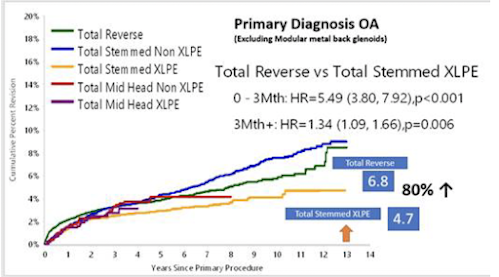In this population-based registry, RTSA had significantly higher short and long term revision rates than TSA with cross linked polyethylene.


The incidences over time for the different indications for revision of RTSA are shown below

The incidences over time for the different indications for revisions of TSA with cross linked polyethylene are shown below

A recent short term (one-year) followup study in the JAAOS compared the demographics, surgical complications, and revision procedures between RTSA and TSA: Surgical Complications After Reverse Total Shoulder Arthroplasty and Total Shoulder Arthroplasty in the United States.
The one year revision rates were higher for RTSA in both the AOA/JSES and the JAAOS studies.

In the JAAOS studhy, patients younger than 50 years had higher one year rates of surgical complications. Male patients had higher RTSA complication rates, whereas female patients had higher TSA complication rates. History of tobacco use, depression, and obesity were risk factors for higher complication rates.
As shown below, the one year rates of infection/drainage, dislocation and fracture were higher for RTSA while the rate of rotator cuff tear was higher for TSA.

From these data it can be seen that the rate of rotator cuff tears after TSA was higher than the rate of revision for TSA, suggesting that patients with cuff tears after TSA may have had sufficiently preserved function and tolerated the cuff defect so they did not want to have a revision to a RSA.
Comment: In spite of the widespread use of RTSA for patients with osteoarthritis and an intact cuff, these two studies do not provide data showing that RTSA has better outcomes than TSA. Further well-controlled population-based studies that include data on patient comfort and function will be necessary to illuminate the value of the two procedures.
You can support cutting edge shoulder research that is leading to better care for patients with shoulder problems, click on this link.
Follow on twitter: https://twitter.com/shoulderarth
Follow on facebook: click on this link
Follow on facebook: https://www.facebook.com/frederick.matsen
Follow on LinkedIn: https://www.linkedin.com/in/rick-matsen-88b1a8133/
Here are some videos that are of shoulder interest
Shoulder arthritis - what you need to know (see this link).
How to x-ray the shoulder (see this link).
The ream and run procedure (see this link).
The total shoulder arthroplasty (see this link).
The cuff tear arthropathy arthroplasty (see this link).
The reverse total shoulder arthroplasty (see this link).
The smooth and move procedure for irreparable rotator cuff tears (see this link).
Shoulder rehabilitation exercises (see this link).

